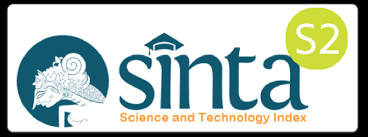Students’ Use of Graphs in Understanding the Concepts of Derivative
Abstract
Keywords
Full Text:
PDFReferences
Alacaci, C., Lewis, S., O’Brien, G., & Jiang, Z. (2011). Pre-Service Elementary Teachers’ Understanding of Graphs. Eurasia Journal of Mathematics, Science and Technology Education, 7(1), 3-14.
Asiala, M., Cottrill, J., Dubinsky, E., & Schwingendorf, K. (1997). The Development of Students’ Graphical Understanding of the Derivative. Journal of Mathematical Behavior 16(4), 399-431.
Aspinwall, L., Shaw, K., & Presmeg, N. (1997). Uncontrollable mental imagery: Graphical connections between a function and its derivative. Educational Studies in Mathematics, 33(3), 301-317.
Baker, B., Cooley, L., & Trigueros, M. (2000). A Calculus Graphing Schema. Journal for Research in Mathematics Education, 31(5), 557-578.
Borgen, K. & Manu, S.S. (2002). What do students really understand? Journal of Mathematical Behavior, 21, 151-165.
Ball, D. L., Hoyles, C., Jahnke, H. N., & Movshovitz-Hadar, N. (2002). The teaching of proof. In L. I. Tatsien (Ed.), Proceedings of the international congress of mathematicians (pp. 907–920). Beijing: Higher Education Press.
Haapasalo, L. & Kadijevich, Dj. (2000). Two types of mathematical knowledge and their relation. Journal für Mathematik-Didaktik, 21(2), 139-157.
Hanna, G., & Jahnke, H. N. (1996). Proof and proving. In A. Bishop, K. Clements, C. Keitel, J. Kilpatrick & C. Laborde (Eds.), International handbook of mathematics education (pp. 877–908). Dordrecht, The Netherlands: Kluwer.
Kamii, C., & Dominck, A. (1998). The harmful effects of algorithms in grades 1–4. In L. J. Morrow, & M. J. Kenney (Eds.), The teaching and learning of algorithms in school mathematics: 1998 yearbook (pp. 130–140). Reston, VA: The National Council of Teachers of Mathematics.
Kosslyn, S. M. (1994). Elements of Graph Design. New York: W.H. Freeman & Co Ltd.
Larkin, J.H., & Simon, H.A. (1987). Why a diagram is (sometimes) worth ten thousand words. Cognitive Science, 11, 65-99.
Lohse, G. L. (1993). A cognitive model for understanding graphical perception. Human-Computer Interaction, 8, 353-388.
Monk, G. S. (1994). Students’ Understanding of Functions in Calculus Courses. Humanistic Mathematics Network Journal, 9, 21-27.
Orton, A. (1983). Students' Understanding of Differentiation. Educational Studies in Mathematics, 14(3), 235-250.
Ratwani, R.M., Trafton, J. G., & Boehm-Davis, D. A. (2008). Thinking graphically: connecting vision and cognition during graph comprehension. Journal of Experimental Psychology: Applied, 14(1), 36-49.
Sharma, S. (2013). Assessing Students’ Understanding of Tables and Graphs: Implications for Teaching and Research. International Journal of Educational Research and Technology, 4(4), 51-70.
Schoenfeld, A. H. (1992). Learning to think mathematically: Problem solving, metacognition, and sense making in mathematics. In D. A. Grows (Ed.), Handbook of research on mathematics teaching and learning (pp. 334-370). New York: Macmillan
Stahley, J. R. (2011). Students’ qualitative understanding of the relationship between the graph of a function and the graphs of its derivatives. Unpublished Master’s Thesis. The University of Maine, USA.
Stylanides, A. J. (2007). Proof and proving in school mathematics. Journal for Research in Mathematics Education, 38(3), 289–321.
Tiwari, T. K. (2007). Computer Graphics as an Instructional Aid in an Introductory Differential Calculus Course. International Electronic Journal of Mathematics Education, 2(1), 32-48.
Ubuz, B. (2007). Interpreting a graph and constructing its derivative graph: stability and change in students’ conceptions. International Journal of Mathematical Education in Science and Technology, 38(5), 609-637.
Uesaka, Y., & Manalo, E. (2011). Task-related factors that influence the spontaneous use of diagrams in maths problems. Applied Cognitive Psycholog, 26, 251-260.
Uesaka, Y., Manalo, E., & Ichikawa, S. (2007). What kinds of perceptions and daily learning behaviors promote students' use of diagrams in mathematics problem solving? Learning and Instruction, 17, 322-335.
Waller, R. (1981). Understanding netwotk diagrams. Paper presented at the Annual Meeting of the American Educational Research Association, Los Angelos, April 1981
Zandieh, M. J. (2000). A Theoretical Framework for Analyzing Student Understanding of the Concept of Derivative. CBMS, Issues in Mathematics Education. (103-127) Providence, RI: American Mathematical Society.
Zimmerman, W. (1991). Visual Thinking in Calculus. In Z. Cunningham (Ed.), Visualization in Mathematics. (Notes # 19, 127-137), Washington, DC: Mathematics Associations of America.
DOI: https://doi.org/10.46517/seamej.v9i1.69
Refbacks
- There are currently no refbacks.
Indexed by:
Southeast Asian Mathematics Education Journal
SEAMEO Regional Centre for QITEP in Mathematics
Jl. Kaliurang Km 6, Sambisari, Condongcatur, Depok, Sleman
Yogyakarta, Indonesia
Telp. +62 274 889955
Email: seamej@qitepinmath.org
p-ISSN: 2089-4716 | e-ISSN: 2721-8546
Southeast Asian Mathematics Education Journal is licensed under a Creative Commons Attribution 4.0 International License
View My Stats
Supported by:



